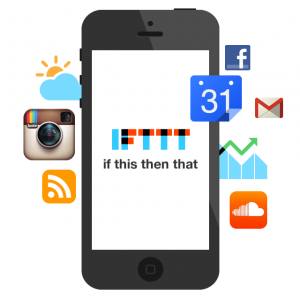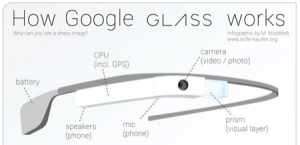“Is that Google Glass? Does it recognize my face and can you see my criminal records?” These are the first questions I received on my first day wearing Google Glass as my wife and I walked toward the Monterey Bay Aquarium during our holiday break. I figured this would be a good place to wear them for the first time since picking up the device from Google’s Venice Beach office the week before. I felt self-conscious and unsure of how folks around me would react. I was pleasantly surprised that while folks at the aquarium gave me a look of curiosity, I didn’t hear any negative remarks. From what I’ve read online and from my conversation with the Google employee who provided me with hands-on training, people’s reactions vary. I also expected at some point to be called a “glasshole“. What I didn’t expect was that I’d be called by this name by another higher ed technologist I really admire after posting a picture of my wife and me on Facebook, a platform I had found to be a safe place for sharing my personal experience. The comment made me think twice about bringing the device to our family holiday party so I ended up keeping them at home. I did regret that decision just because I wasn’t able to capture many of the fun moments we had as a family throughout the night, especially during the white elephant game.
My initial experience with Google Glass is in some ways similar to when I started speaking about wearable computing, mobile, social media, cloud, and even the web way back in the mid-1990s. Some folks were excited and there were those skeptical of the new “fad//toy/useless/wasteful to business” technologies. Given how visible Google Glass is on one’s face, the potential benefits as well as potential ethical/privacy issues it represents, I think opinions on both sides will be stronger this time. In a conversation with a friend, I mentioned how Google Glass could be used for photojournalism, and immediately, his response was “or voyeurism” to which I immediately agreed with this unfortunate possibility.
I bought Google Glass for professional and personal reasons. Professionally, I want to explore how this device could be used in student affairs and in higher ed. I’d like to connect with other folks who are already thinking about the applications of Google Glass in higher ed. The ability to play around with the device itself has certainly helped me think more about the possibilities. One function I’ve found useful is the ability to take photos through the wink feature while I’m on the go. It’s really convenient to take photos without having to take my iPhone out of my pocket.
I also bought Google Glass for personal reasons, primarily for golf. I’m curious as to how I could use it to improve my swing at the driving range. Apparently, I have a tendency to sway and move my head a lot and this is not a good thing. Using Google Glass to record my movement while I’m swinging should help analyze these problems. Another use is for GPS on the course. Two days ago, I tried using it with the available golf glassware on the course, with not much luck. Given my limited experience with Google Glass over the last two weeks, here are my initial observations:
Pros:
-Easy to learn. While there’s some learning curve involved, I was quickly able to figure out the basic gestures (back, forward, down swipes, tap) and voice commands for the device to be usable. Connecting the device to my iPhone (personal hotspot/Bluetooth) and with my wi-fi weren’t too difficult either. There were very specific steps involved, which includes pointing the Google Glass to a QR Code to connect it to the network, so I just made sure not to miss any steps.
– It fits comfortably and adjusting it is very easy. The frame is made with titanium and so it’s strong and malleable.
– The wink feature, just recently added, is by far my favorite and most convenient to use. That I didn’t have to take my iPhone out nor did I have to issue a voice command “OK Google take a picture” to take photos is nice.
– Social media sharing. There are two ways to share photos/videos. The first option is to “Send” to an individual who is in your Google+ contact. The second option is to “Share” on Twitter or Facebook. I’ve been able to share a photo via Twitter (tagged with #throughglass) but I’m still figuring out how to share on Facebook. I suspect this is because I have two-factor authentication enabled.
– Screencasting. The guest feature, which allows a Google Glass owner to share the device with others without exposing their personal information, has been disabled with the newest version. Screencasting, a feature that allows the display of what is on the Google Glass screen on a paired mobile device on the same network, is very convenient for demos.
– Google Support. My experience with the support team has been superb since I first inquired about how to be in the Explorer Program months ago. Whether through their Twitter account (@googleglass), via e-mail, phone calls, and the staff at the Google office, I’ve received very timely, professional, and friendly support.
Cons:
– I wear prescription glasses without them, the smaller text is hard to see as they are blurry. I will now have to use contact lenses for me to use the device. Another option, which I’ve already signed up for is to get a prescription eyeglasses for Google Glass.
– Wink feature doesn’t work with the shades on. While this should have made sense to me, I had to laugh at myself for not realizing this would not work since the camera could not detect my wink behind the shades. The problem with this is that I will most likely need the shades to see the screen better when I’m outside, like playing golf. I would like to use the wink feature, but it will not work.
– The case is a little bulky. The device doesn’t fold like a regular pair of glasses so it’s stored in a
Given my limited experience with Google Glass, I have many features to learn and I will be sharing them in the future as I use them.
As I’ve done with new technologies I’ve come across during my professional life, I look at Google Glass not only from a technologist’s perspective but from one who is curious about the sociological implications of this device. How will folks interact with me and what concerns will they bring up? I also try to look at this device from a student affairs perspective. As wearable computing becomes more prevalent, how will these devices change the way students communicate, how they build relationships, and how do they impact their identities in the way they represent themselves to others? How can we use these devices as part of our work? What ethical/legal/policy/privacy issues need to be considered?
 I like gadgets and discovering how I can use them beyond how they come out of the box. One fun part about having these gadgets is figuring out how to integrate them with other devices and services. This is where IFTTT (If This Then That) comes in. IFTTT is a service that, through triggers and actions, can enable different devices and services, including cloud, mobile, wearable computing, social media, and the internet of things, to work together. I use Evernote, Dropbox, iPhone/iPad/Samsung Galaxy Note, Fitbit, Pebble watch, Google Glass, Nest Thermostat, Automatic app, and various social media platforms. I’ve experimented with some IFTTT “Recipes,” a combination of triggers and actions, just for fun and to see what I can use for productivity. Listed below are a few of the recipes I’ve used:
I like gadgets and discovering how I can use them beyond how they come out of the box. One fun part about having these gadgets is figuring out how to integrate them with other devices and services. This is where IFTTT (If This Then That) comes in. IFTTT is a service that, through triggers and actions, can enable different devices and services, including cloud, mobile, wearable computing, social media, and the internet of things, to work together. I use Evernote, Dropbox, iPhone/iPad/Samsung Galaxy Note, Fitbit, Pebble watch, Google Glass, Nest Thermostat, Automatic app, and various social media platforms. I’ve experimented with some IFTTT “Recipes,” a combination of triggers and actions, just for fun and to see what I can use for productivity. Listed below are a few of the recipes I’ve used: